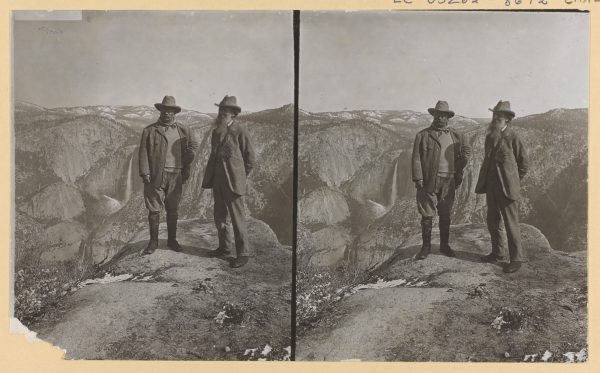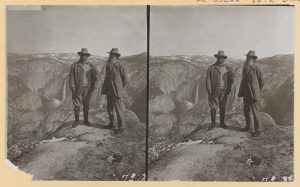
Right Now with Warren Kagarise (Linkedin/Twitter/Instagram)
What I’m watching: The latest installment of “The Great British Baking Show” for the increasingly complicated treats and the Instagrammable setting.
What I’m reading: “Parks” — a chronicle of America’s Best Idea through 103 years’ worth of National Park Service brochures, maps, memorabilia and other ephemera.
You can find a simple credo on signs at all varieties of public lands, from neighborhood trails to the most-visited national parks: Take only pictures. Leave only footprints.
Today is National Public Lands Day, when state and national parks offer free admission and people from coast to coast participate in the largest single-day volunteer effort for public lands.
National Public Lands Day is also a time to take stock of how social media, particularly Instagram, is reshaping our relationship with the great outdoors.
Stories abound throughout the United States and Canada about how social media is leading to a deluge of new visitors to public lands — as well as more litter, more strain on already stretched infrastructure, and more people unfamiliar with basic outdoor skills, Leave No Trace principles and trail etiquette.
The phenomenon started attracting attention and concern in the last decade, paralleling the rise of Instagram and influencer culture.
Apple added front-facing cameras to the iPhone 4 in 2010 — coincidentally the same year Instagram launched. In 2013, by the time Instagram had amassed more than 150 million monthly users, Oxford Dictionaries named selfie as the Word of the Year.
With smartphone cameras improving, attention spans shrinking and the pressure increasing to capture ❤️-worthy photos, public lands offer breathtaking backdrops to wannabe influencers and others doin’ it for the ‘gram.
The most-discussed example is Horseshoe Bend, on the Colorado River in Arizona, where officials recently added parking and railings after the destination became #Instafamous.
Before we blame the influencers, remember: Documenting our experiences on public lands is even older than the concept of public lands.
Thomas Moran’s dreamy landscapes of Yellowstone nudged Congress in 1872 to set aside the area as the world’s first national park. Ansel Adams, perhaps the best-known person to advance conservation through photography, helped create Kings Canyon National Park in 1940.

Since then, though, technology evolved to help us capture, edit and share awe-inspiring photos instantly. Now, a single geotag can move hundreds of people — a vast audience potentially unfamiliar with the rules and customs of our shared outdoor spaces.
In 2018, Wyoming’s Jackson Hole Travel and Tourism Board made a puzzling request to visitors bound for Grand Teton National Park: Stop geotagging photographs, after Instagram-inspired visits put pressure on once-remote trails throughout the area.
The phenomenon is not limited to public lands. Worldwide, museums, landmarks and other cultural institutions have experienced a similar rush. Amsterdam even removed the iconic “I am Amsterdam” sign due to the influx of selfie-seeking visitors.
If you think I sound holier-than-thou, I admit I am just as guilty as everyone else of following the geotags.
Following selfie-related deaths at national parks, the National Park Service created a guide to safe selfies. Throughout the United States and Canada, parks agencies have installed signage warning people of risks, as well as barriers to limit access to dangerous terrain.
And, of course, Yellowstone National Park needed to remind visitors about the potentially fatal hazard of taking a selfie with a bison.
Nationwide, public agencies also encourage behaviors to “activate” public lands in a safe way. In Minnesota, state land managers sought to curate the visitor experience by adding selfie stations to state parks and trails. Meanwhile, next door in Iowa, 80 counties added selfie stations to celebrate the county parks network.
With more new visitors heading to public lands, Leave No Trace offered updated social media guidelines to help lessen impacts on the environment.
Taken on balance, social media has been a positive force for the national parks, helping a century-old institution reach a new audience and enabling people to experience a connection, however fleeting, with natural wonder. (Yosemite National Park alone claims more than 1.5 million followers on Instagram.)
On the opposite side, vigilante accounts have sprung up to shame people for bad or illegal behavior, notably @publiclandshateyou and @youdidnotsleepthere.
Shaming is up for up debate. Leave No Trace recommends against the practice. And I worry shaming edges dangerously close to cyberbullying and the other types of unsavory online behavior many of us work to combat.
Maybe the real issue isn’t the influx of influencers, but instead a lack of attention and investment in public lands. Instagram, and social media more broadly, offer a powerful way to build conservation advocacy, demonstrate inclusivity and illustrate how everyone is welcome on public lands.
After all, this land is your land.
